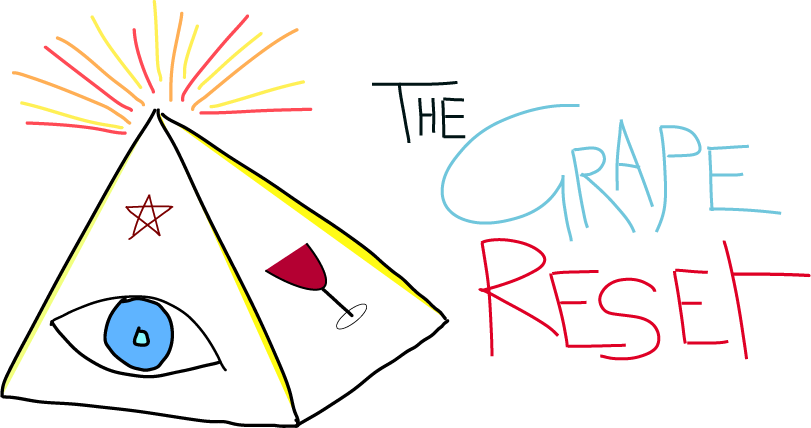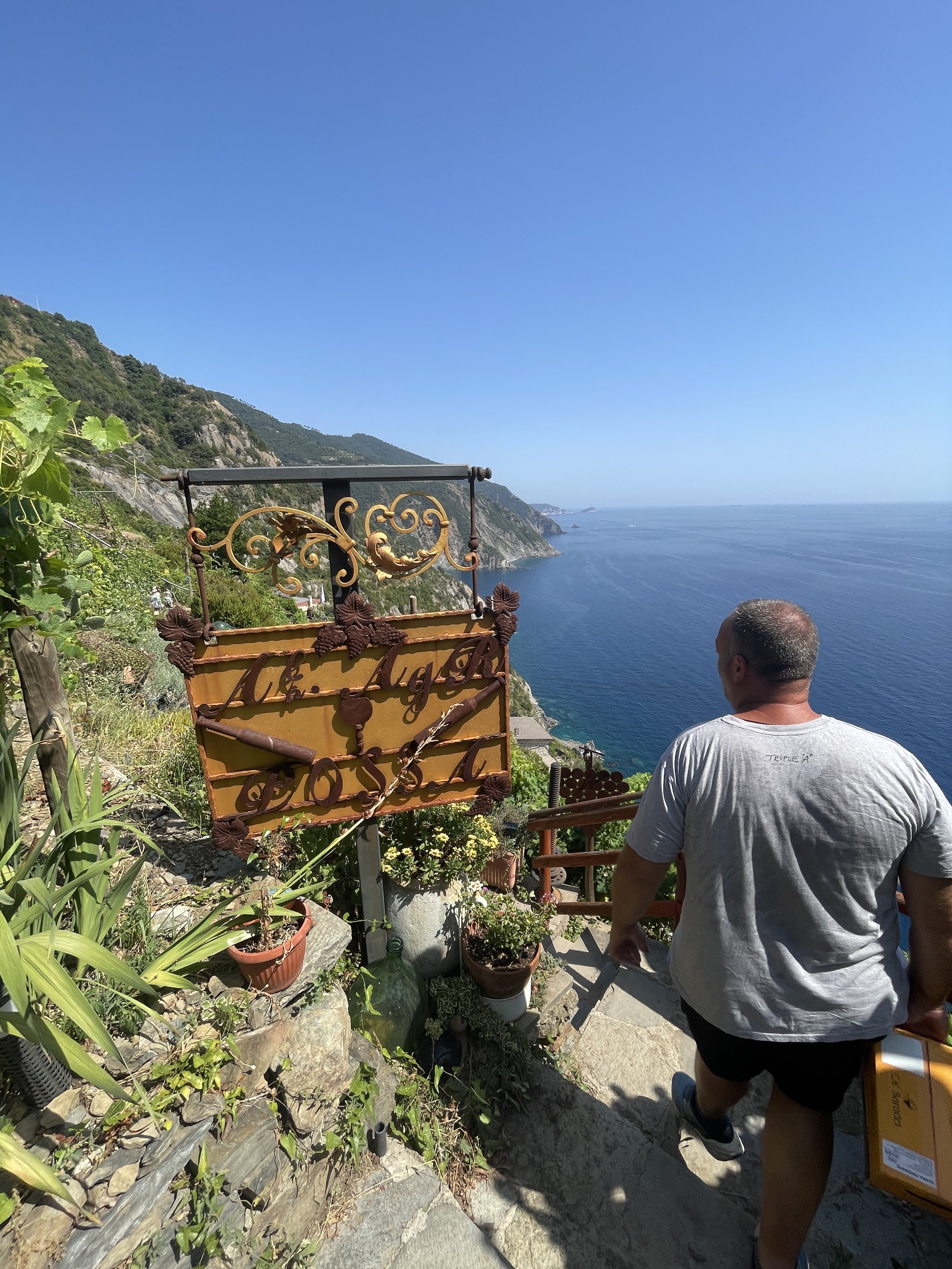Agricola Possa - Cinque Terre
I've been hiking the small paths of Cinque Terre for years now—just a four-hour drive away. This stunning landscape, with its beautiful Mediterranean flora, has always captivated me. After years of wandering through lemon and olive groves and seeing the once-thriving vines slowly deplete, I finally had the chance to visit Agricola Possa.
I met Bonanini Samuele Heydi of Agricola Possa at the tourist office atop Riomaggiore, where crowds of tourists swarmed. Bonanini seemed unfazed by it all, accustomed to the summer influx. Over the past decade, visitor numbers have skyrocketed, largely thanks to Instagram's influence.
The tiny plots clinging on to the terraced mountain , a walls are constructed and maintained by hand using dry diking system.
Agricola Possa, however, remains a world apart from globalization, though not entirely untouched. Bonanini carefully balances using the tourist presence to promote his wine, the region, and sustainability. His mission is to protect indigenous grape varieties and preserve traditional methods of production and harvesting in southern Cinque Terre—a formidable task. He learned from the village elders how to tend the vines, build the ancient walls, and master vinification.
It’s a remarkable story, where Agricola Possa's vines thrive in a botanical and traditional time capsule, just a few hundred meters from one of the world's most visited tourist destinations.
in 1970 there were 6000 hectares of vines some indigenous some abandoned and mostly newer and more productive verities replacing the indegenoius ones that we see most of the world.
The entrance to the super steep terraced vines 1 km East of Riomaggoire.
Driven by a dream to reintroduce the ancient vines that once thrived in the area 1,000 years ago, he is determined to revitalse the land where his grandparents once cultivated grapes. Over time, 95% of the vines were lost to decay, neglect, and general abandonment, as many locals found it easier to secure government or factory jobs without the financial risks of farming.
Maintaining the terraced walls is crucial. Without the expertise to preserve these structures, the entire mountainside risks collapsing into the Mediterranean Sea below.
Tumbling down into the sea
In 1970, there were 6,000 hectares of vineyards, consisting of a mix of indigenous varieties and some abandoned plots. However, most of the indigenous varieties were being replaced by newer, more productive strains. These commercial varieties, which became popular in the 1960s and 1980s, mirrored the trends seen in much of the world at that time.
Bonanini Samuele Heydi has conducted a thorough search for 19 native grape varieties in the Cinque Terre region and planted them on the steep slopes of Riomaggiore. These indigenous varieties include Rossese Bianca, Piccabon, Bonamico, Canaiolo, Bosco, Alberola, and Red Moscato, as well as some rare and forgotten varieties like Barba Rossa, White Galleta, Red Galleta, and Red Queen, which are unique to Possa.
Buying up the land
No easy task , starting when he was 19 he released that the the bougoius from Milan and Turin where starting to buy up small ancient plots of vines to make little holiday homes from the adondanded vinerogons huts , a race against time , a beurocratic nightmare , all but one area has been acquired and is still in process of semi rewilding due to foresight , vision and sheer determination , the step amphitheater with native flowers herbs and grapes. in total 74 small private pieces of land have been acquired to creat the steep stepped parcels that we see today.
Boar Problem
No sleep from April until Harvest , this year sees a huge problem with boars eating the grapes , spring was particularly wet in which a lot of vegetation over grew the electric fence and making it redundant , so quite a lot of loss this year. they also bring fungisis from the other adonded vines bringing desisie to Possa vines. adding more stress and constant monitering.
Anello dell'isola Palmaria
Vermentino is grown here Palmaria Island, with an area just under 2 km², is the largest of the three islands in the Gulf of La Spezia and in the entire Ligurian region. Together with Tino and Tinetto, it forms the entire archipelago of La Spezia.
The island is located opposite the village of Portovenere, separated from it by a narrow stretch of sea known as "Le Bocche."
In this small triangular piece of land, gently sloping down to the sea, the typical Mediterranean vegetation gives way to a small vineyard of just over 3,000 square meters.
The grapes grown and harvested here are transported by boat to the mainland, and it is from these clusters that the "Palmaea" wine is produced, based on Vermentino, Trebbiano, and Albarola grapes.
1000 year old Cave , dug out from the rock in the village of Riomaggoire
in the 100 year old cave in Rio Maggoire , Now to small to vinify anything other that the Cinque Terre Sciacchetrà .Preferring to use only wood that grows abunadtly and locally Bonanini has searched out barrels from Modena , that once aged balsamic made from acacia , chestnut and wild black cherry only trees that are indigenous to the Cinque Terre.
Bonanini Samuele Heydi
a remarkable individual , his attention and passion to history , agriculture and botany is remarkable , a sense of huge responsabilty to the land and it’s vine growing history is tangible..
Anello dell'isola Palmaria - Vermentino is grown here Palmaria Island, with an area just under 2 km², is the largest of the three islands in the Gulf of La Spezia and in the entire Ligurian region. Together with Tino and Tinetto, it forms the entire archipelago of La Spezia.
The island is located opposite the village of Portovenere, separated from it by a narrow stretch of sea known as "Le Bocche."
In this small triangular piece of land, gently sloping down to the sea, the typical Mediterranean vegetation gives way to a small vineyard of just over 3,000 square meters.
The grapes grown and harvested here are transported by boat to the mainland, and it is from these clusters that the "Palmaea" wine is produced, based on Vermentino, Trebbiano, and Albarola grapes.
In the Cave
Bonanini is also working with the Red Cross , training migrants in wine making in the cellar and in the vineyard.
A small training area and educational plots are used to teach local children, aged 6 to 14, about the area's history and to show them how to cultivate and care for vines. The goal is to inspire them to consider a future in winemaking, thereby preserving local traditions
@AgricolaPossa







